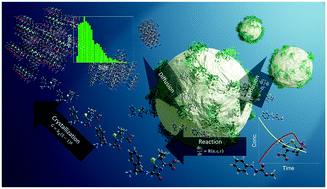Model development for enzymatic reactive crystallization of β-lactam antibiotics: a reaction–diffusion-crystallization approach†
Abstract
Enzymatic reactive crystallization of β-lactam antibiotics provides a promising method for efficient and large-scale manufacturing. Since practical processes rely on immobilized enzyme for operation, a robust process model needs to take into account three phenomena of enzymatic reaction, species diffusion, and crystallization of the products. In this work a mathematical model and a numerical simulation procedure are developed for enzymatic reactive crystallization using penicillin G acylase immobilized on a porous carrier. Enzymatic reaction is described using previously established kinetic parameters for a commercial enzyme. An experimentally measured diffusivity is used to model the mass transport resistance, and a 1-D population balance model is used for crystallization of needle-like crystals from supersaturated species. The effect of five immobilization parameters, loading, carrier type and size, enzyme distribution, and carrier size distribution is systematically investigated using the developed model and their implications are discussed for synthesis of two β-lactam antibiotics, ampicillin and cephalexin, with different turnover rates. As expected, using carriers with larger radius, higher loading, and smaller diffusivity is shown to lead to significant mass transport resistance and deviation from free enzyme behavior. This effect is more drastic for the ampicillin system, which has faster dynamics due to lower affinity of enzyme for its nucleophile agent. Testing different enzyme distributions, it is shown that accumulation of enzyme at the outer regions of the carrier leads to an improved process and mitigation of mass transport resistance due to higher sensitivity of diffusion timescale to radius, compared to reaction timescale to enzyme concentration. Adding a crystallization module to the model allowed for dynamic modeling of processes with high substrate concentrations applicable to reactive crystallization. Effect of pH as a critical process parameter affecting both reaction and crystallization is discussed, as well as potential intra-carrier crystallization and consequent enzyme blockage.



 Please wait while we load your content...
Please wait while we load your content...
